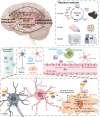Alzheimer's disease pathogenesis: standing at the crossroad of lipid metabolism and immune response
- PMID: 40468377
- PMCID: PMC12139291
- DOI: 10.1186/s13024-025-00857-6
Alzheimer's disease pathogenesis: standing at the crossroad of lipid metabolism and immune response
Abstract
Alzheimer's disease (AD) is a neurodegenerative disorder characterized by macroscopic features such as cortical atrophy, narrowing of the gyri, widening of the sulci, and enlargement of the ventricles. At the cellular level, the pathological characteristics include the extracellular aggregation of β-amyloid (Aβ) forming senile plaques, and the intracellular accumulation of hyperphosphorylated tau proteins forming neurofibrillary tangles. AD leads to the progressive decline of cognitive, behavioral, and social abilities, with no effective treatment available currently. The pathophysiology of AD is complex, involving mechanisms such as immune dysregulation and lipid metabolism alterations. Immune cells, such as microglia, can identify and clear pathological aggregates like Aβ early in the disease. However, prolonged or excessive activation of immune cells may trigger chronic neuroinflammation, thereby accelerating neuronal damage and the progression of AD. Lipid metabolism plays a critical role in maintaining cell membrane structure and function, regulating the production and clearance of Aβ, and supplying energy to the brain. Disruptions in these processes are closely linked to the pathological progression of AD. The interaction between lipid metabolism and the immune system further exacerbates the disease progression of AD. In this review, we discuss the lipid metabolism and immune response in AD, summarize their intricate interactions, and highlight the complexity of the multifactorial pathogenic cascade, offering insights into new interventions targeting the immune-metabolic axis in AD.
Keywords: Alzheimer's disease; Immune response; Immunometabolism; Lipid metabolism; Molecular mechanism.
© 2025. The Author(s).
Conflict of interest statement
Declarations. Ethics approval and consent to participate: Not applicable. Consent for publication: All authors read and approved the final manuscript. Competing interests: The authors declare no competing interests.
Figures



Similar articles
-
Alzheimer's disease.Subcell Biochem. 2012;65:329-52. doi: 10.1007/978-94-007-5416-4_14. Subcell Biochem. 2012. PMID: 23225010 Review.
-
C/EBPβ in Alzheimer's disease: An integrative regulator of pathological mechanisms.Brain Res Bull. 2025 Feb;221:111198. doi: 10.1016/j.brainresbull.2025.111198. Epub 2025 Jan 7. Brain Res Bull. 2025. PMID: 39788461 Review.
-
A Recent Update on Pathophysiology and Therapeutic Interventions of Alzheimer's Disease.Curr Pharm Des. 2023;29(43):3428-3441. doi: 10.2174/0113816128264355231121064704. Curr Pharm Des. 2023. PMID: 38038007 Review.
-
Immune Modulation in Alzheimer's Disease: From Pathogenesis to Immunotherapy.Cells. 2025 Feb 12;14(4):264. doi: 10.3390/cells14040264. Cells. 2025. PMID: 39996737 Free PMC article. Review.
-
Inflammasome-Mediated Neuroinflammation: A Key Driver in Alzheimer's Disease Pathogenesis.Biomolecules. 2025 May 7;15(5):676. doi: 10.3390/biom15050676. Biomolecules. 2025. PMID: 40427569 Free PMC article. Review.
Cited by
-
Pathological mechanisms and treatment progression of Alzheimer's disease.Eur J Med Res. 2025 Jul 14;30(1):625. doi: 10.1186/s40001-025-02886-9. Eur J Med Res. 2025. PMID: 40660381 Free PMC article. Review.
References
-
- Chen S, Cao Z, Nandi A, Counts N, Jiao L, Prettner K, Kuhn M, Seligman B, Tortorice D, Vigo D, et al. The global macroeconomic burden of alzheimer’s disease and other dementias: estimates and projections for 152 countries or territories. Lancet Glob Health. 2024;12(9):e1534–43. - PubMed
Publication types
MeSH terms
Substances
Grants and funding
LinkOut - more resources
Full Text Sources
Medical

